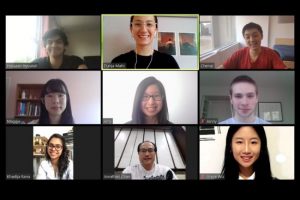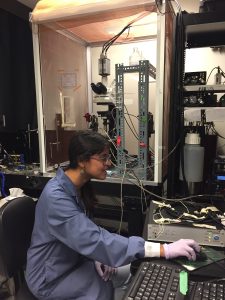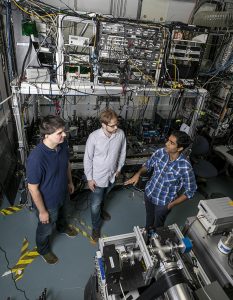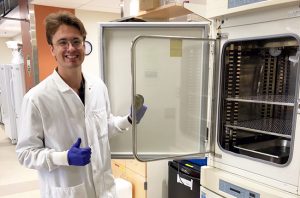EngSci students have made valuable research contributions and gained important life experiences during summer research placements at U of T and partner institutions around the world.
They have developed insights into research processes, made professional connections, and expanded their horizons working with diverse graduate students and researchers.

Learn more about the Engineering Science Research Opportunities Program (ESROP), on our Summer Research Overview page.
Location: King Mongkut's University of Technology Thonburi (KMUTT), Bangkok, Thailand
Supervisor: Professor Jonathan Chan (EngSci 8T4, ChemE MASc 8T7, PhD 9T5)
 Dunja is one of eight EngSci who were scheduled to travel to KMUTT for summer research placements when the pandemic began.
Dunja is one of eight EngSci who were scheduled to travel to KMUTT for summer research placements when the pandemic began.
Professor Chan and colleagues quickly adapted the plan to allow students to conduct their research remotely, with frequent online meetings, seminars and other events.
Dunja worked on using physiological data from EEGs or ECGs to train algorithms to classify emotions. Another project used deep learning (a form of artificial intelligence) to predict the effects of genetic variations.
Learn more about how ESROP - GLOBAL pivoted in 2020 due to COVID-19.
Location: Carnegie Mellon
Supervisor: Professor Peter Zhang (EngSci 1T1, MIE MASc 1T3)
 When the pandemic hit, Lauren's plan to spend the summer at Imperial College London fell through.
When the pandemic hit, Lauren's plan to spend the summer at Imperial College London fell through.
"I was really looking forward to the hands-on experience working in a research lab, as well as going to Europe for the first time," she says. "After that fell through, I didn't have many ideas for a new summer position."
But a few days after the cancellation, an email arrived with a new opportunity: working remotely on pandemic modelling at Carnegie Mellon University with Professor Peter Zhang (EngSci 1T1, MIE MASc 1T3).
"I thought it looked really interesting," says Lauren. "I got an interview and was accepted in early May to start the remote placement. We hope to uncover fundamental physical laws of epidemic processes by designing novel Explainable AI (XAI) methods."
Learn more about how summer research in 2020 pivoted due to COVID-19.
Location: U of T's Micro/Nanophotonics Research Group
Supervisor: Professor Joyce Poon (EngSci 0T3)
 "My primary project was helping a graduate student characterize his on-chip wavelength-tunable semiconductor laser design. I also helped characterize passive device designs for a wafer-scale dimensional variation tolerance project.
"My primary project was helping a graduate student characterize his on-chip wavelength-tunable semiconductor laser design. I also helped characterize passive device designs for a wafer-scale dimensional variation tolerance project.
"Since pretty much everything on the optical table could be described as some combination of expensive, fragile, tiny, and difficult to handle, I quickly learned valuable lessons related to caution and patience. There was a lot of practical problem-solving in designing, assembling, and debugging the measurement apparatuses. Embedded in that process was writing MATLAB scripts that simultaneously controlled up to 5 pieces of lab equipment. I also analyzed the measurements, attended and presented at meetings, and presented at the Undergraduate Engineering Research Day (UnERD) conference.
"What I particularly enjoyed was that there was an abundance of opportunities for me to learn more about both the specific field of photonic integrated circuits and research in general. Much of that came from talking to various graduate students in the building and asking them a silly amount of questions. I was also able to attend numerous talks on a variety of research topics given by Institute of Electrical and Electronics Engineers (IEEE) guest speakers. All in all, what I learned this summer definitely helped me develop a better idea of what my long term career goals are."
Location: Max Planck Institute, University of Hamburg, Germany
 "I was fortunate to spend a four-month long research term in Hamburg, Germany at the Max Planck Institute for the Structure and Dynamics of Matter within the Center for Free Electron Laser Science. For the three of us in the lab, our summer project was to develop software along with the hardware to utilize a pair of rotatable mirrors and a focusing lens inside of a vacuum chamber to anneal a silicon chip with an infrared laser.
"I was fortunate to spend a four-month long research term in Hamburg, Germany at the Max Planck Institute for the Structure and Dynamics of Matter within the Center for Free Electron Laser Science. For the three of us in the lab, our summer project was to develop software along with the hardware to utilize a pair of rotatable mirrors and a focusing lens inside of a vacuum chamber to anneal a silicon chip with an infrared laser.
"Specifically, the silicon chips to be placed inside of the annealing setup are those found in electron microscopes. After time and use, the silicon crystal structure deteriorates reducing the capability for high quality and useful image production. Currently, to anneal the silicon chips requires an oven temperature lower than the melting point of solder to heat the entire silicon chip setup (several million euros) for around two weeks. However, with laser annealing, the same silicon chip setup can be placed in vacuum chamber and just the silicon chip can be targeted by the laser, heating it to higher temperatures than before, allowing the annealing process to happen over several hours - all without damaging the other sensitive electrical components.
"My role was focused on hardware and the physical setup. My biggest task was to design an experimental setup that heats up thin wires to 400 degrees Celsius and image them with an infrared camera to create a relationship between measured temperature (by a thermocouple near the wires) and the thermal camera readings. The setup tests the spatial resolution of the camera by viewing the wires through a slit perpendicular to the direction of the wires to simulate a point source like what the laser would produce. These are vital things to test to make sure the silicon chip reaches the annealing temperature at the spot where the laser hits.
"I was also responsible for electromechanical work and hardware setup such as: soldering, circuit making, using driver boards, wiring between components, configuring a PID, assembling and disassembling the entire setup, preparing the vacuum chamber for use, mounting the imaging cameras, and mounting components within the chamber.
"Aside from the incredible opportunity at work, I took advantage of the opportunity to travel as much as I could. I visited Amsterdam, Geneva, the Alps, Berlin, Prague, and took an overnight train to Paris. And of course, I saw Hamburg through its festivals on the harbour, night life in the Reeperbahn, art shows in an old bunker, and even just buying and selling a bike I used for commuting. Being able to travel taught me budgeting, exposed me to so many different people and cultures, but most importantly, pushed me beyond my comfort zone - all while doing research which developed my workplace and technical skills."
Location: U of T's Faculty of Medicine
Supervisor: Prof. Taufik Valiante
 "I worked as a student researcher at the Neuron to Brain Laboratory located in the Krembil Discovery Tower. My research involved understanding the effects of a particular stimulation technique called coordinated reset on neurons to determine how it can be used for seizure reduction in epilepsy patients. We performed an in-vitro experiment using mouse hippocampal slices that were stimulated and recorded with multielectrode arrays. We took extracellular recordings i.e. recordings from a population of neurons and measured the changes in their excitability.
"I worked as a student researcher at the Neuron to Brain Laboratory located in the Krembil Discovery Tower. My research involved understanding the effects of a particular stimulation technique called coordinated reset on neurons to determine how it can be used for seizure reduction in epilepsy patients. We performed an in-vitro experiment using mouse hippocampal slices that were stimulated and recorded with multielectrode arrays. We took extracellular recordings i.e. recordings from a population of neurons and measured the changes in their excitability.
"This research gave me real insight into the life of a researcher: It involved full day experimentation, analyzing collected data, reasoning deviation from expected results and modifying experimental procedure to account for these deviations. Experiments were sensitive to various factors including the time taken for brain removal, the thickness and oxygenation of the tissue, noise levels in recordings etc. Debugging and troubleshooting of the setup given the large number of variables and parameters involved in the experiment was a time consuming effort. I was involved at each step of the process and thus got the opportunity to work with state of the art equipment and develop new experimental skills. I have a fundamental understanding of wet lab procedure which is essential to research in biomedical engineering, the field of my interest. I also developed a program for analyzing data which helped improve my programming skills.
"Although my main interest has always been biomolecular sciences, I have gained a newfound appreciation for neurobiology. I was introduced to neurostimulation and its applications which can help investigate the brain and have a significant impact on treating neurological disorders. I have decided to continue assisting with this research over the next year and possibly pursue a future at the intersection of biomolecules and neurobiology. I can now design the course structure of the upcoming academic years to accommodate this.
"This interest would not have developed were it not for the warm and learning conducive environment of the lab. I learned a lot about by simply asking lab members about their research.
"This summer also provided me opportunities to present the research in various forms. I created a poster for the UnERD conference held at UofT and presented a formal speech on Krembil Summer Students' Research Day at my research institute. I thus gained experience in both styles of presentation in front of different audiences.
"This summer was not all work and no play. All the summer students would go out for lunch every Friday to take advantage of the diverse food options available at Kensington Market, merely one block away from our workplace. The most exciting events were the farewell dinner with several members of our lab including Dr. Valiante and the annual picnic with the Intelligent Sensory Microsystems Laboratory under Professor Roman Genov. Such events presented casual settings to get to know each better and have fun."
Location: Harvard University
Supervisor: Professor John Doyle
 "I had the opportunity to work on the Advanced Cold Molecule Experiment (ACME) whose goal is to measure the electron's electric dipole moment (EDM) using a cryogenic beam of heavy polar molecules. Finding the EDM would be a clear signature of physics beyond the standard model.
"I had the opportunity to work on the Advanced Cold Molecule Experiment (ACME) whose goal is to measure the electron's electric dipole moment (EDM) using a cryogenic beam of heavy polar molecules. Finding the EDM would be a clear signature of physics beyond the standard model.
The experiment is a precision measurement that is done in collaboration with three groups at Harvard, Yale and Northwestern. This allowed me to have a unique experience as I was able to partake in a world-class experiment while also working with people from different universities and backgrounds.
"For my part on the experiment, I worked on testing models related to lasers turning on improperly that lead to excess noise in the most recent measurement. This involved building optics set-ups as well creating a data acquisition system and devising sensible tests to understand how noise enters through the lasers turning on. This provided me with the opportunity to really think critically about the underlying physics and what the best way is to understand the noise without a clear path for how to do so.
"Unlike previous research I have done, the experiment was well past the building phase and focused on doing the measurement. This provided me with new insight for what the day-to-day of research is like. While the experience was very different, it further cemented my goal to pursue graduate school in atomic physics with a focus on precision measurements.
"Another great thing about working at Harvard was the environment of phenomenal students and researchers nearby. I got to meet many people who are experts on exciting/growing topics like molecules, quantum gas microscopes and quantum computation. Even the students and postdocs I worked with every day served as great mentors and provided insight into how they approach doing physics. Spending the summer at Harvard really expanded my network and has allowed me to make many friends who might be future colleagues, collaborators and contributors in the field.
"Outside of working at Harvard, I really enjoyed my time living in Cambridge. It's a vibrant place filled with interesting architecture that can both be modern or European. There's always plenty of fun activities to do like getting food at Harvard square or kayaking in the nearby Charles river. I'm even proud to say that I have an encounter with the mythical Cambridge Turkey!"
Location: National University of Singapore
 Helen's research focused on enhancing the manufacturing process of a nano-material for use in solar reflective films. She investigated the production of UV and IR filtering Distributed Bragg Reflectors (DBRs). These are produced through dip-coating alternating layers of TiO2 and SiO2 colloidal solutions, to create a material that reflects UV and IR but allows the transmission of visible light. Compared to other such films, DBRs can be fabricated at low temperatures, making them suitable for application to materials like plastic.
Helen's research focused on enhancing the manufacturing process of a nano-material for use in solar reflective films. She investigated the production of UV and IR filtering Distributed Bragg Reflectors (DBRs). These are produced through dip-coating alternating layers of TiO2 and SiO2 colloidal solutions, to create a material that reflects UV and IR but allows the transmission of visible light. Compared to other such films, DBRs can be fabricated at low temperatures, making them suitable for application to materials like plastic.
Helen worked on the application technique and chemical composition of the colloidal solutions. This work exposed her to nanotechnology and materials science, fields she had not explored before.
"From operating scientific equipment, to designing my own experimental procedures with complete freedom, to resolving problems independently, working in a lab was indeed a brand-new experience. Although nerve-wracking at first, I grew to enjoy the lab environment. I especially enjoyed listening to the advancements made in other cutting-edge research projects by colleagues, and coming to the lab every morning with new ideas and anticipation. On top of understanding what research is about, I also became an expert at operating a variety of technical equipment - such as the Scanning Electron Microscope and the UV-Vis-NIR-Spectrophotometer - which are valuable skills to have for future endeavours in grad school and research.
"Having the chance to go to Singapore was an unforgettable travel experience. I was able to visit a variety of attractions, within and outside of Singapore. I can still recall the smells of delicious street food at the Jonker Street night market in Malacca, feel the thrills tickling down my spine as I recall myself standing in a glass box three hundred metres above the ground on Kuala Lumpur Tower, and hear the loud music that accompanied the Spectra Light Show on Marina Bay Sands echoing in my ears.
"I especially treasure the new friendships that I built in the matter of eight weeks, with fellow Engineering Science students, colleagues, and locals. It was never difficult to start a conversation with a Hawker Center Chef while ordering dishes, with a stranger who is queuing behind you, or with lab colleagues in the Canteen during lunch."
Location: Massachusetts Institute of Technology
Supervisor: Dr. Kwanghun Chun
 “I joined the lab because of its expertise in the field of tissue clearing and brain imaging; as a student in biomedical engineering, I’m interested in learning more about the novel techniques used to screen and treat brain disorders.
“I joined the lab because of its expertise in the field of tissue clearing and brain imaging; as a student in biomedical engineering, I’m interested in learning more about the novel techniques used to screen and treat brain disorders.
“I conducted research under the supervision of Dr. Alexandre Albanese (IBBME PhD 1T4), a post-doctoral fellow interested in characterizing the phenotype of cell populations in cerebral organoids (mini brains) using 3D whole-tissue imaging. In short, if there is something wrong with your brain, we can grow organoids with your DNA to study your neurons’ behavior.
“Human brains are highly vascularized, with more than 100 000 kilometers of blood delivering oxygen and nutrients to keep the cells alive. Mini-brains, however, lack a vasculature. To address this fundamental limitation of the in-vitro brain model, the Chung lab is printing synthetic microvasculature to perfuse organoids.
“My summer project consisted of culturing endothelial cells on the luminal (inside) surface of the microvasculature. The objective was to improve the biological accuracy of the in-vitro model by introducing a platform to facilitate cell co-culture. Some of my achievements include the development of a cell culture protocol on the vasculature, and design improvements to enhance its biological applications. In the future, this biomaterial could be used for other organoid models and implants. My independent summer project was a great opportunity to apply the skills learned in EngSci courses such as fluid mechanics (AER210), cell culture (BME205) and rapid prototyping (AER201). This summer was also an occasion to learn new skills; I learned sterilization techniques used to clean an incubator infested with fungi, I designed and fabricated scaffolds using 3D printed molds, and I became interested in computational image analysis using machine learning.
“It was a great privilege to be part of MIT, a community which was both scientifically and artistically stimulating. Though my stem cells required daily love and attention, I managed to escape to the beach on weekends, run along the Charles River at night, and attend a concert on a boat. I want to extend my thanks to the Division of Engineering Science for helping me fund this opportunity, as well as all the members of the Chung Lab for a memorable summer.”
Location: University of California, San Diego
Supervisor: Professor Patricia Hidalgo-Gonzalez
I was reading the weekly EngSci student newsletter, trying to distract myself from a quantum physics problem set, when a posting caught my eye: The UCSD Renewable Energy and Advanced Mathematics Lab is recruiting. “Well, that sounds interesting,” I thought! Renewable energy is an important topic and all EngScis clearly love math. I contacted Prof. Hidalgo-Gonzalez and after some months of part-time work with the team I was offered a summer research position to study a topic that turned out to be absolutely fascinating.
Coal and gas power plants emit a quarter of the United States’ greenhouse gas emissions. A challenge of using renewable energy is that wind and solar energy are weather-dependent. If it’s cloudy or the wind has died, they won’t produce much electricity. But engineers and researchers are trying to figure out how to supply electricity when the wind isn’t blowing and the sun isn’t shining.
We can charge rechargeable batteries when the sun is bright, and use the stored energy when it’s cloudy. But this tends to provide energy for only a few hours. We need energy storage that can provide energy for weeks or even entire seasons. This is called long-duration energy storage.
I studied the Western US electricity grid using a computer model to understand needs for long-duration energy storage in a future where we no longer use gas or coal power plants.
This was a linear programming model representing components of the energy grid (transmission lines, power plants, etc.) as sets of linear equations with variables (the number of solar panels to build, how much electricity to send along a transmission lines at a specific time, etc.). An algorithm finds the variable values that minimize the total system cost (the optimal values). I could test different scenarios to see how the optimal grid behaved. The fact that I can model an entire energy grid on a computer amazes me!
I discovered complex interactions in our energy grid. E.g., increasing droughts--perhaps due to the climate crisis—would increase the need for long-duration energy storage. Droughts cause hydroelectric dams to work less effectively. Hydroelectric dams are one of the only renewable technologies we can control to fill in during periods of low sun or wind. It is these interactions that make the energy grid so fascinating to study!
Over the summer, I got to use my software and programming experience. I automated many of our workflows and built software tools to help future team members. I also reduced the “solve time” of our algorithm from dozens of hours to approximately 90 minutes, allowing us to study many more models at higher resolutions.
This summer has convinced me to select EngSci’s Energy Systems Major! I’m excited to learn the theory behind the topics that I explored in my research. I’ve learnt that modelling in general is about being thoughtful in the decisions and assumptions.
What I loved the most was putting my engineering knowledge towards an issue that matters. Like most people my age, the climate crisis affects me directly. From my travels and trips into nature, I have learned to see beauty in our environment, and the destruction that is and will continue to happen to humans and our planet saddens me. I have found it incredibly rewarding to work in a field that is transforming itself in response to the climate crisis. Although my contributions are small, I am surrounded by like-minded, motivated and smart people who give me great hope in our ability to drive change.